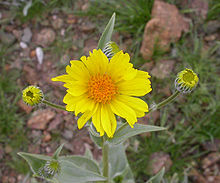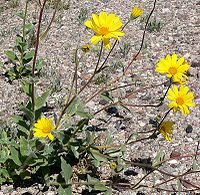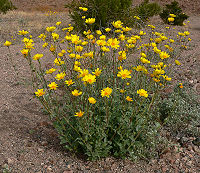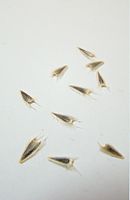- Geraea canescens
-
For other uses, see Desert Sunflower (disambiguation).
Geraea canescens 
Desert Sunflower (Geraea canescens) Scientific classification Kingdom: Plantae (unranked): Angiosperms (unranked): Eudicots (unranked): Asterids Order: Asterales Family: Asteraceae Genus: Geraea Species: G. canescens Binomial name Geraea canescens
Torr. & GrayGeraea canescens is also known as the desert sunflower, hairy desert sunflower, or desert gold. It is a dicot and annual of the Aster (Asteraceae) family. "Geraea" in its scientific name comes from the Greek geraios ("old man"), referring to the white hairs on the fruits.[1]
The desert sunflower has a yellow sunflower-like flower, each flower on a slender, hairy stem. It grows 1-3 feet (0.3–1 m) high. The leaves are gray-green and grow to 3 inches (7.6 cm) long. It flowers February through May after sufficient rainfall.
It is native to western North America, specifically Arizona, Nevada, California, and Utah. A drought-avoiding annual plant, it can be found in the California, Mojave, and Sonoran Deserts. It grows from sea level to 4,265 feet (1,300 m) in sandy desert soil in the company of creosote brush.[2]
The flowers attract bees and birds. Seeds are eaten by birds and rodents.[3]
There are two varieties of Geraea canescens:
- Geraea canescens var. canescens
- Geraea canescens var. paniculata S.F.Blake
References
- ^ Geraea canescens. Lady Bird Johnson Wildflower Center. http://www.wildflower.org/plants/result.php?id_plant=GECA2
- ^ CalFlora Taxon Report. http://www.calflora.org/cgi-bin/species_query.cgi?where-taxon=Geraea+canescens
- ^ Desert Sunflower. Desert USA. http://www.desertusa.com/mag99/feb/papr/desunflower.html
External links
- USDA. Geraea canescens Torr. & Gray. Hairy Desertsunflower. PLANTS Profile.
- Geraea canescens. Lady Bird Johnson Wildflower Center.
- Picture of Desert Sunflowers in Death Valley
- CalPhotos page for desert sunflower
- Map of the Desert Sunflower's range

This Heliantheae article is a stub. You can help Wikipedia by expanding it.





